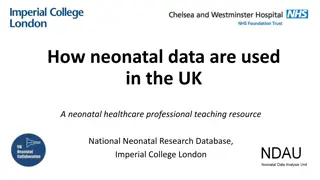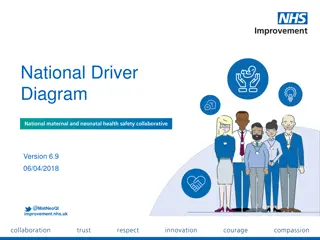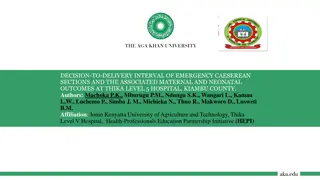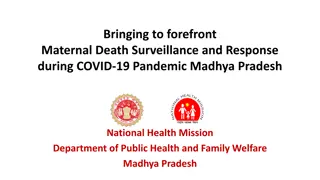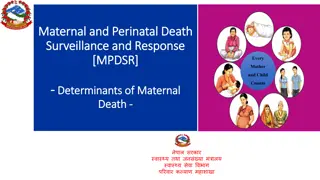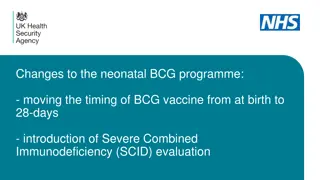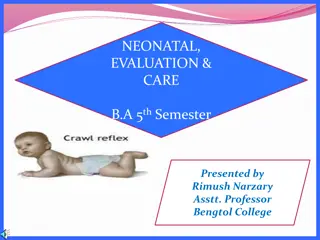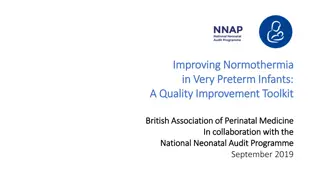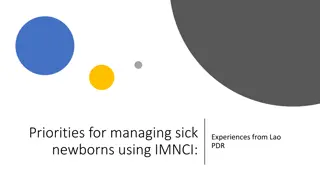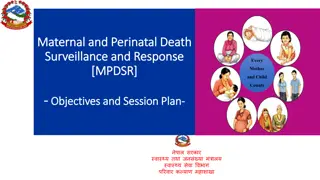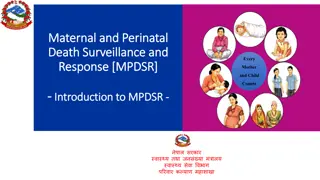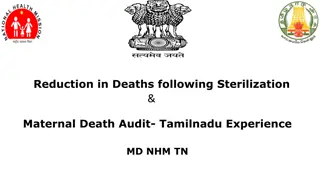Maternal and Neonatal Healthcare Insights
The data highlights key components, operational aspects, major causes, and timing of maternal and neonatal deaths. It emphasizes the critical period around delivery for both mothers and babies, stressing the need for interventions during this vulnerable time to reduce mortality rates. The information underscores the significance of proper care and timely interventions to prevent maternal and neonatal deaths, with a focus on where women are at the highest risk and the essential actions needed for newborns.
Download Presentation

Please find below an Image/Link to download the presentation.
The content on the website is provided AS IS for your information and personal use only. It may not be sold, licensed, or shared on other websites without obtaining consent from the author. Download presentation by click this link. If you encounter any issues during the download, it is possible that the publisher has removed the file from their server.
E N D
Presentation Transcript
DAKSHATA Key Components and Operational Aspects of Dakshata
Timing of Maternal Deaths Maternal mortality > 2/3rd deaths happen in 1st 48 hours Intra partum 16% Antepartu m 25% Birth Day 28% Rest of first month after birth 31% Problem Statement: Most mortality is centred around delivery (intra and immediate postpartum period) Source: The Lancet (DOI:10.1016/S0140-6736(14)60496-7) Source: Ronsmans C, Graham WJ. Maternal mortality: who, when, where, and why. The Lancet. 30 eptember;368(9542):1189 200. 2 Source:: JE Lawn et al.; Every newborn, progress, priorities and potential beyond survival; The Lancet (DOI:10.1016/S0140-6736(14)60496-7).
Major Causes of Maternal Mortality and Interventions to Prevent them AMTSL, Oxytocin/ Misoprostol, Blood transfusion Haemorrhage 27% Others 31% Antibiotics, IP, TT, 6 cleans FP and post-abortion care Sepsis 11% Abortion 8% BP measurement, Anti hypertensive, MGSO4 Obstructed labor 9% Monitor labour with Partograph, LSCS Hypertensive disorders 14% Source- WHO 2014 3
Timing of Neonatal Deaths Neonatal mortality and stillbirths (5.5 million) Intra partum 21% Antepartum 27% Birth Day 19% Rest of first month after birth 33% Problem Statement: Most mortality is centred around delivery (intra and immediate postpartum period) Source: The Lancet (DOI:10.1016/S0140-6736(14)60496-7) Source: Ronsmans C, Graham WJ. Maternal mortality: who, when, where, and why. The Lancet. 30 September;368(9542):1189 200. 4 Source:: JE Lawn et al.; Every newborn, progress, priorities and potential beyond survival; The Lancet (DOI:10.1016/S0140-6736(14)60496-7).
Causes of Neonatal Deaths Immediate breathing assessment, resuscitation Antibiotics, IP, TT, 6 cleans Birth asphyxia 19% Infections 34% Others 5% Malformation s 8% Antenatal corticosteroids, KMC, assisted feeding Preterm 34% Data source: ICMR-2006 5
Where are women at the time of highest risk? Period of maximum risk for mother (and baby): Needs more focus Woman is in facility. Most interventions happen in labour rooms 6
What is needed? <1.4 million babies Advanced Resuscitation (<1%) Approx. 6 million babies Basic Resuscitation (3-6%) Approx. 10 million babies Simple stimulation at birth to help them breathe (5-10%) 136 million babies born All babies require immediate assessment at birth and simple newborn care Simple evidence based practices save lives 7 Wall et al. Int J Gyn & Obs 2009, 107: s47- s64
Simple, Evidence Based Practices Save Lives AMSTL has been shown to reduce the incidence of PPH (>1/3 of maternal deaths in India) by up to 66%. Use of MgSO4 in severe pre-eclampsia has been shown to reduce progression to eclampsia by 58% & reduce deaths by up to 45%. Use of the partograph to monitor labor/identify complications early has been shown to reduce early neonatal deaths by 40% Antibiotics for preterm premature rupture reduces the incidence of infections by 32% 8
What Does Quality of Care Mean? All Practices Performed Performed in Each Case Evidence-based, high impact practices Performed in a Timely Manner Performed as per Standards 9
Dakshata Goal: Strengthened Quality of Care through Competent and Confident Providers. Expected Outcome: Improved adherence to highest impact practices Modus Operandi (Strategic Approach): Through a 360 degree but focused and scalable approach, to address the major determinants of quality-thus ensuring TRANSLATION OF SKILLS TO PRACTICE 10
Key Components of Dakshata Focused and customized training Resource availability Dakshata Strategy for transfer of learning Improved monitoring and accountability
Role of WHOs Adapted SCC Skill building Resource availability SCC is a framework for Use of Data Mentorship
Key Component 1: Focused and Customized Training Concise: 3 days duration Includes highest impact practices Competency based: Blended learning approach- Simulation, Case based practice For all LR staff
Training Methodology For skill building For For Hands on practice Knowledge Evening LR visits Use of Models Interactive PPTs Providers need to stay at district Case based practice AV Aids-Videos
COMPETENCIES Around 4 pause points: - At admission - Before/ during delivery - After delivery - At time of discharge 15
Pre-requisites for Successful Training Training of providers from district level facility Fully functional district level facility in terms of resource and evidence based practice Identification and Training of Trainers (ToT) Identification of sites with high delivery load: First to be saturated Assessment of training load: Available HR will be mapped during RA Micro-planning for training: For clubbing of facilities Participation by all labor rooms staffs irrespective of previous training status
Key Component 2: Strategy for Transfer of Learning Engagement of facility leadership Orientation of the clinical and administrative leaders Non- rotation of LR staff Post training follow-up and mentoring support For translation of skills into practice Post training FUP
Mentorship For tech support: Dedicated pre-identified personnel For program support: RMNCH+A consultants For Admin support : District level program managers/ supervisors Mentors First visit within 15 days of completion of training After that once every 15 days for 2 months Once in a month for 6 months subsequently once every quarter for the next 3-4 quarters Frequency of Visits First observe practices by the trained provider On the job handholding Review of facility records Give feedback to nursing in-charge Content of Visits
Key Component 3: Ensuring Resource Availability Dakshata envisages that before initiating training, resource availability must be ensured Following actions are recommended to ensure supplies: Resource availability analysis: during rapid assessment data will be collected on availability of resource at point of use Facility-specific action matrices:Based on RA findings action matrix will be prepared with level of intervention Ensuring supplies at LR: based on action matrix, RMNCH+A consultants can be used to fulfill the resource gaps
Key Component 3: Ensuring Resource Availability Advocacy action for additional HR & PIP support Identifying needs for relocating existing HR Non-rotation of trained HR State Inclusion of essential supplies in supply chain Introduction of new essential supplies/ packages of supplies Planning/PIP support Assessments District Improved supply chain for essential supplies Improved commodity monitoring Facility Addressing local bottlenecks Availability at point of use
Key Component 4 : Improved Monitoring and Accountability Different formats are being used for recording of data Dakshata aims to bring uniformity in data recording ad reporting through: Standardardized Case Sheet Standard Birthing Register (from MNH toolkit) Dashboard of indicators
Key Component 4 : Improve Monitoring and Accountability
Implementation of the MNH Tool kit Intermediate term objective Implementation of the MNH Tool kit at the delivery points, in a phased manner. Priority will be given to hiring of additional human resources at the designated delivery points
Major considerations Skill building Data for action Preparation Resourcing Hiring of quality mentors Training micro plan Data recording Assessments Identification of teams Resource availability Data reporting Trainings Sensitization of district officials Post training support
Tentative schedule of activities Sensitization Workshop for district and facility level officials on Dakshata program Implementation of data recording tools and dashboard indicators 3 days on-site training of labour room staff at district hospitals Post-training follow- up and support to district hospitals Post training follow- up and support to SDL facilities by trainers and mentors Identification and mapping of target facilities with resource availability Ensuring availability of essential supplies and other resources Preparation of training micro-plan for each facility Rapid Assessment of resource availability and practices status 5 days training of trainers and quality improvement mentors 3 days training of staff from sub- district level facilities at DH Hiring of quality improvement mentor
Plan for operationalization Before training Training Post training Sensitization Workshop for district and facility level officials 5 days training of trainers and quality improvement mentors Post-training follow-up and support to district hospitals Identification and mapping of target facilities 3 days on-site training of labour room staff at district hospitals Post training FUP and support to SDL facilities by trainers/ mentors Hiring of quality improvement mentor 3 days training of staff from sub-district level facilities at DH Program monitoring and corrective actions RA for resource availability and practices status Data recording tools and dashboard indicators Ensure all essential supplies Preparation of training micro- plan for each facility


